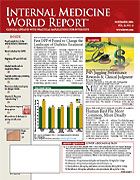Publication
Article
Internal Medicine World Report
Meeting Highlights: New Priorities in Emergency Care
Author(s):
From the American College of Emergency Physicians Information Technology Offers Novel Solutions
NEW ORLEANS—Reports presented at the American College of Emergency Physicians (ACEP) annual meeting included results from a range of studies that have important emergency preparedness implications for physicians. A large focus of the meeting centered on the incorporation of information technology in medicine and its impact on emergency preparedness.
Newly elected ACEP President Brian Keaton, MD, of Summa Health System, Akron, Ohio, said at the meeting, “Information technology is changing the way today’s emergency departments operate. There are technologies to speed the flow of patients through bottlenecks, share medical information records, and allow laboratory tests and films to be viewed instantly and simultaneously at multiple sites.”
Dr Keaton emphasized that “while technology alone can’t solve the problems in our nation’s healthcare system, it is an incredibly valuable tool that will help us work better, faster, and smarter. Many emergency departments that are operating at critical capacity are looking for solutions to improve patient care, increase patient safety, and improve efficiency.”
Emergency Contact on Cell Phone
Almost 3 in 4 emergency department patients and visitors will agree to program their cell phones with an emergency contact name and phone number, under the acronym ICE (in case of emergency), when physicians or other healthcare providers explain why it is important to do so.
Dennis McKenna, MD, of Albany Medical Center, Albany, NY, recruited 178 patients waiting in an emergency department who had cell phones with them. After listening to an educational session, 129 agreed to have an emergency contact designated on their phone. Of these, 36 had a family member program the number, and 35 allowed hospital staff to program the number for them. “We often are struggling to reach family members when a patient cannot speak to us, and the first place we might look is a cell phone,” Dr McKenna said.
“A family member or friend is one of our best resources for learning about the patient’s medical history. Our study shows that people are very willing to program their phones, as long as someone tells them why and how to do it—or even does it for them.”
“For the Love of the Game”
Men may put off a visit to the emergency department until the game they are watching on television ends. David Jerrard, MD, of the University of Maryland Medical Center, Baltimore, reported on a 3-year study that examined emergency department registration patterns at his hospital. The number of men checking into the emergency department increased following all 796 of the sporting events (ie, professional and college football, professional baseball, college basketball) he reviewed.
Approximately 50% more men came to the emergency department after a professional football game had ended than while the game was still on, and 30% to 40% more men sought care after a baseball game was over. The study did not address what health conditions brought the men to the emergency department. Dr Jerrard said additional research is needed to explain the reasons for the delays, but the obvious conclusion is that the men did not want to miss what happened during the games, even if it meant postponing taking care of their health.
Americans Unprepared for Disaster
Americans are unprepared for a terrorist attack or a natural disaster, regardless of whether they are active or retired military personnel or civilians, reported Richard Dagrosa, MD, and John McManus, MD, both military emergency physicians. They anonymously surveyed people in San Antonio, Tex, including families seen in 2 military hospital emergency departments, 50 of whom were active duty (AD), 40 retired military (RM), and 54 civilian personnel (CP).
Although those with a military background, either in AD or retired, were slightly more prepared, no significant differences were found among any of these groups regarding their preparedness for a disaster. Results showed that most did not have a disaster plan (56% AD; 55% RM; 48% CP); most did not have a disaster kit (36% AD; 33% RM; 22% CP); and most did not designate a meeting place in the event of disaster (53% AD; 54% RM; 31% CP).
The majority of the respondents reported feeling even less prepared after taking the survey.






